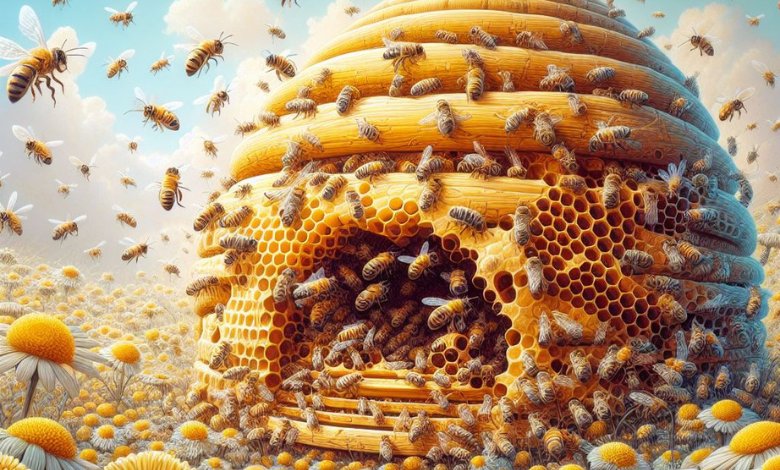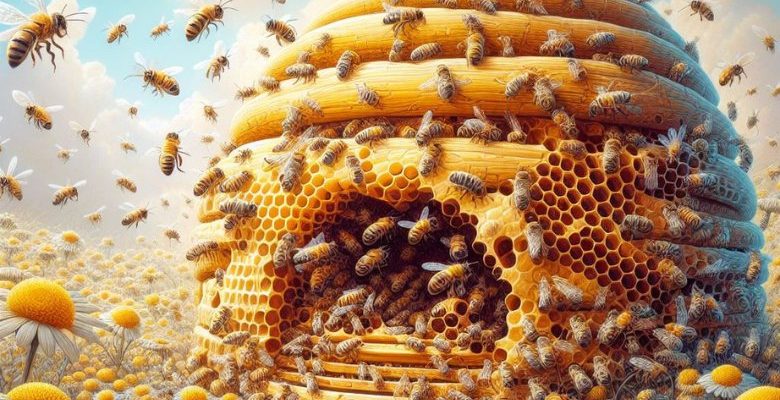
Honestly, the inner workings of a bee hive are nothing short of extraordinary. From the moment you get close to a hive, you might hear the gentle hum of bees working together, which is like a symphony of nature. Each bee is part of a larger community where cooperation is key to survival. But what exactly happens behind those walls? Let me explain this remarkable ecosystem and the roles each bee plays in maintaining it.
The Hive Structure
A bee hive is an architectural wonder. At its core, it’s made of hexagonal wax cells, which are incredibly efficient for storing honey and raising young bees. This structure is created by worker bees, who secrete wax from special glands on their abdomens. Think of it as a combination of construction work and interior design, where each cell serves a purpose.
Inside a typical hive, you’ll find several layers of these honeycomb cells. The bottom cells are usually for raising brood (baby bees), while the upper layers store honey and pollen. This organization is crucial because it keeps food supplies close to where they’re needed, ensuring that the brood can quickly access the nourishment required for their growth.
In addition to the honeycomb, a hive also contains several important rooms. The queen’s chamber is her exclusive area, while worker bees have designated areas for performing specific tasks. This form of organized chaos might seem overwhelming, but it’s the bees’ innate understanding of their environment that makes everything run like clockwork.
The Roles of Bees in the Hive
Inside a bee hive, every bee has a role to play. Let’s break it down:
- The Queen: The star of the hive, the queen is responsible for laying eggs and ensuring the hive continues to thrive. She can lay up to 2,000 eggs a day!
- Worker Bees: These females do all the hard work, including foraging for food, cleaning the hive, and caring for the brood. They’re the backbone of the hive.
- Drones: Males in the hive, drones have one main job: mating with the queen. They don’t collect nectar or pollen, and after mating, they usually die.
You might be wondering how these roles are assigned. Typically, a bee’s age determines its job within the hive. Younger bees often stay inside to care for the brood, while older bees venture out to forage. It’s a well-planned system that allows the hive to function efficiently.
The Life Cycle of Bees
The life cycle of a bee is fascinating and can be broken down into four key stages: egg, larva, pupa, and adult.
1. Egg: The queen lays eggs in the cells of the hive. These eggs hatch after about three days.
2. Larva: Once hatched, larvae are fed a diet of royal jelly by worker bees. This special food determines whether they become a queen or a worker bee.
3. Pupa: After a week of growing, the larvae form a cocoon and enter the pupal stage, where they undergo metamorphosis.
4. Adult: After about three weeks, the bees emerge as adults, ready to take on their roles in the hive.
Each stage is carefully monitored by the worker bees, ensuring that the hive remains healthy and productive. It’s a cycle of life that showcases nature’s incredible design.
The Role of Honey and Pollen
Honey and pollen are the lifeblood of a bee hive. Honey serves as a vital energy source, especially during winter when flowers are scarce. The bees make honey by collecting nectar from flowers, which they then transform into honey through a process of regurgitation and evaporation.
Pollen, on the other hand, is packed with protein and is essential for feeding the brood. Worker bees collect pollen on their legs and transport it back to the hive. You can think of honey as the carbohydrate boost, while pollen is the protein-packed power food. Together, they support the hive’s health and productivity.
When bees visit flowers, they also play a crucial role in pollination. As they collect nectar and pollen, they transfer pollen from one flower to another, helping plants reproduce. This symbiotic relationship benefits both bees and flowers, showcasing how interconnected our ecosystem really is.
Communication Among Bees
Bees are great communicators. Have you ever seen a bee perform a “waggle dance”? This dance isn’t just for fun; it’s how bees convey information about food sources to other hive members. By waggling their bodies, they indicate the direction and distance to flowers rich in nectar.
Not only do bees use dances to communicate, but they also emit pheromones—chemical signals that convey different messages. For example, the queen releases pheromones that signal her presence and keep the worker bees aligned with her needs. This blend of movement and scent ensures that the hive operates smoothly.
Communication is vital for the survival of the hive. It helps maintain harmony and ensures that every bee knows its responsibilities. Imagine trying to run a household without clearly communicating who does what—it would be chaos!
Challenges Inside the Hive
Even in the well-organized world of a bee hive, challenges arise. Pests like Varroa mites can threaten the bees’ health, leading to weakened colonies. These parasites attach to bees and feed on their blood, which can spread diseases and reduce their lifespans.
Additionally, environmental changes—such as pesticide use and habitat loss—can impact food sources for bees. When flowers are scarce, bees struggle to find enough nectar and pollen, which can lead to food shortages in the hive.
To combat these issues, beekeepers often monitor hives for signs of stress and disease. Taking preventive measures can help maintain the health of the hive and support bee populations for the future.
Why Bee Hives Matter
The importance of bee hives goes far beyond the sweet honey they produce. Bees play a massive role in our ecosystem, helping to pollinate a significant portion of the crops we rely on for food. Without healthy bee populations, our diets would look drastically different.
Understanding what happens inside a bee hive helps us appreciate the hard work these tiny creatures put in every day. Protecting bee habitats and supporting sustainable beekeeping practices can help ensure that these vital insects continue to thrive. The next time you enjoy a meal with fruits or veggies, remember the countless bees that helped make it possible!
Each aspect of a bee hive, from the roles of individual bees to the challenges they face, showcases the beauty and complexity of nature. By learning about this remarkable world, we can take steps to ensure it flourishes for generations to come.
In closing, the world inside a bee hive is a remarkable example of teamwork. With their unique roles, communication methods, and critical contributions to our ecosystem, bees truly deserve our respect and protection. Whether you’re a honey lover or just curious about nature, understanding what happens inside a bee hive opens up a fascinating perspective on the wonders of life.

